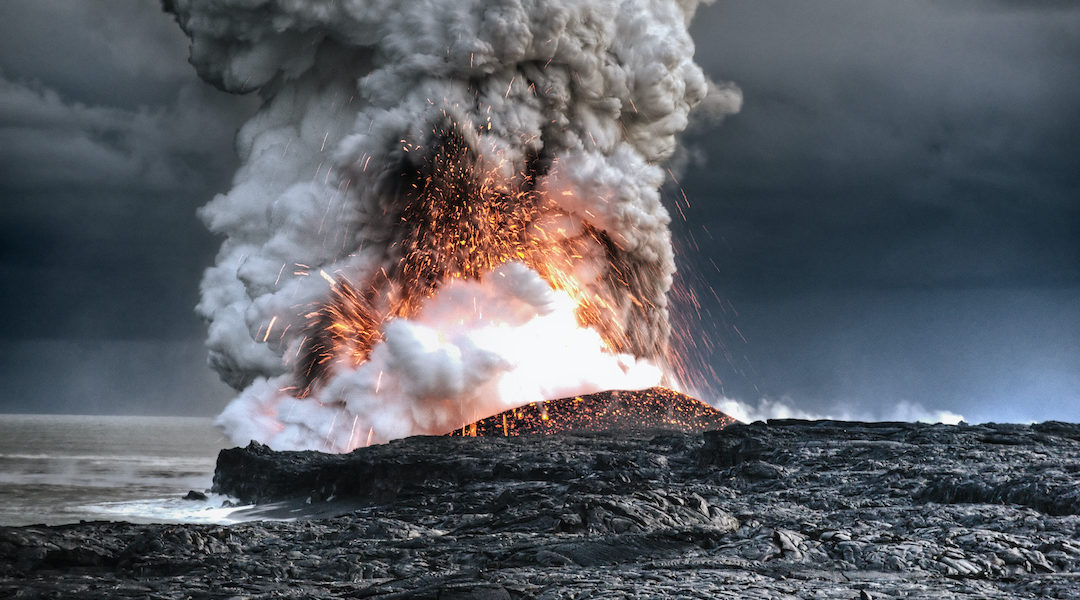
Mauna Loa Volcano Is Erupting. Here’s What Travelers to Hawai’i Need to Know.
The event is part of a rare dual eruption in Volcanoes National Park on the Big Island.

Getty Images
Update: As of December 13, the Mauna Loa lava activity has paused and there is no new lava outside the vent. Kīlauea also is no longer erupting. Lava supply to the Halemaʻumaʻu lava lake ceased on December 9, based upon lava lake levels and behavior of the crater floor.
Mauna Loa, the world’s largest active volcano, began erupting late Sunday night at around 11:30 p.m. on the island of Hawai’i, marking the first time it’s done so since 1984. The eruption is part of a rare dual eruption event with nearby Kilauea, also part of Hawaii Volcanoes National Park, providing a unique opportunity for volcanologists and travelers to witness an awe-inspiring, albeit harrowing event in natural history that the native Hawaiians believe connects them with the great molten creator, Pele. The situation is being closely monitored by scientists from the Hawaiian Volcano Observatory and Hawai‘i Emergency Management Agency, which are providing regular updates.
Though the current lava flow isn’t an immediate threat to local communities, officials have told those living on the Big Island to prepare for evolving scenarios. Volcanologists and local officials are carefully measuring seismic activity as the lava flows northward, with most of the communities lying south, leaving them currently out of harm’s way. Hawai’i’s governor has said that travel can continue as planned, with major tourist areas like the Kohala Coast, Kona, and Hilo being out of the downward path of the current lava flow.

Getty Images
Though the spatters of magma aren’t an immediate threat, the impacted air quality index, also known as AQI, is an issue for those with compromised respiratory systems. Ash, debris, and small shards of glass called Pele’s hair can be incredibly dangerous to breathe. Volcanoes characteristically spew sulfur dioxide and other volcanic gases creating a volcanic smog, or vog, when they mix with vapor, oxygen, and dust in sunlight. As with wildfires, even those who are not compromised will want to avoid athletic activities outdoors. (We like to use an app like IQAir which monitors AQI globally.)
“Hawaiʻi Volcanoes National Park is keeping close watch on Mauna Loa in tandem with our colleagues at USGS and Hawaiʻi County Civil Defense,” said Hawaiʻi Volcanoes National Park Superintendent, Rhonda Loh in a statement on the NPS website. “The park is currently open, but visitors should be prepared and stay informed.”
Currently, flights into Ellison Onizuka Kona International Airport at Keāhole (KOA) and Hilo International Airport (ITO) are operating normally, with an exception from Southwest Airlines, which has cancelled five flights operating from Hilo. Both Southwest Airlines and Hawaiian Airlines, the two major carriers to the islands, are offering travel waivers for those with upcoming flights.
Though most flights are still operating, it doesn’t mean that travelers should go volcano chasing. Officials have urged the public to stay away from the calderas, which have been spattering lava at up to 200 feet. Evacuations and road closures are being posted regularly on the Hawaiian Department of Transportation Website. Currently Maunaloa Road is closed from Kīpukapuaulu to the summit caldera, with the main section of Hawaiʻi Volcanoes National Park remaining open.
Travelers should regularly check on the status of their flight with their respective airline, and be aware of any change fees. As with all travel, insurance is always a smart bet to protect yourself and your pocketbook against the unexpected. The tourism authority is posting regular updates on their website. They advise visitors staying in communities downslope of Mauna Loa to have emergency preparedness plans ready in the event an evacuation becomes necessary.
Whatever you decide regarding your upcoming travels, keep in mind you’re observing a sacred event on wahi kapu, or sacred landscapes, so no matter what your beliefs are, it’s important to keep a level of respect and humility towards this once-in-a-lifetime, awe-inspiring natural phenomenon.
Read the Current Issue Here!
Get one year of Sunset—and all kinds of bonuses—for just $29.95. Subscribe now!
